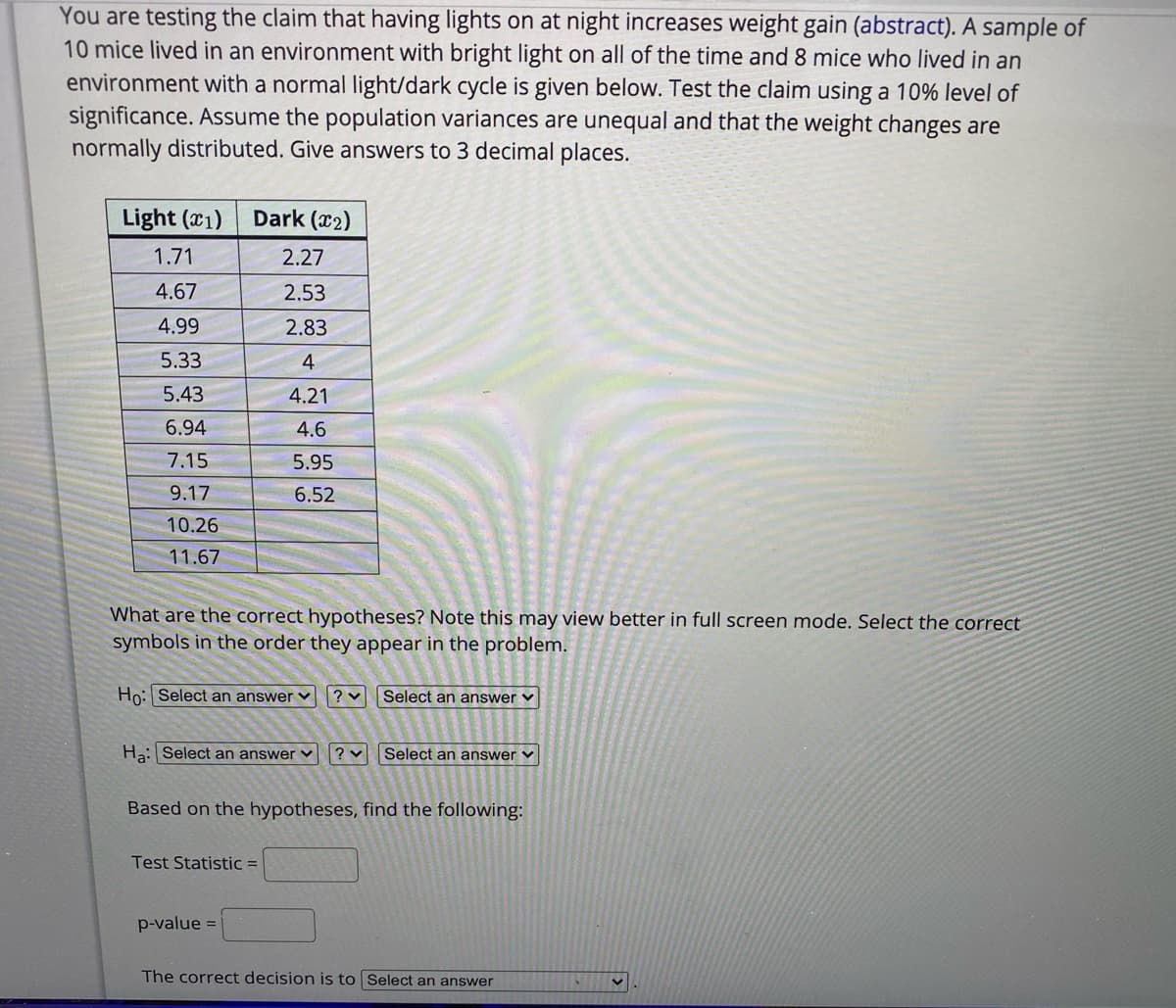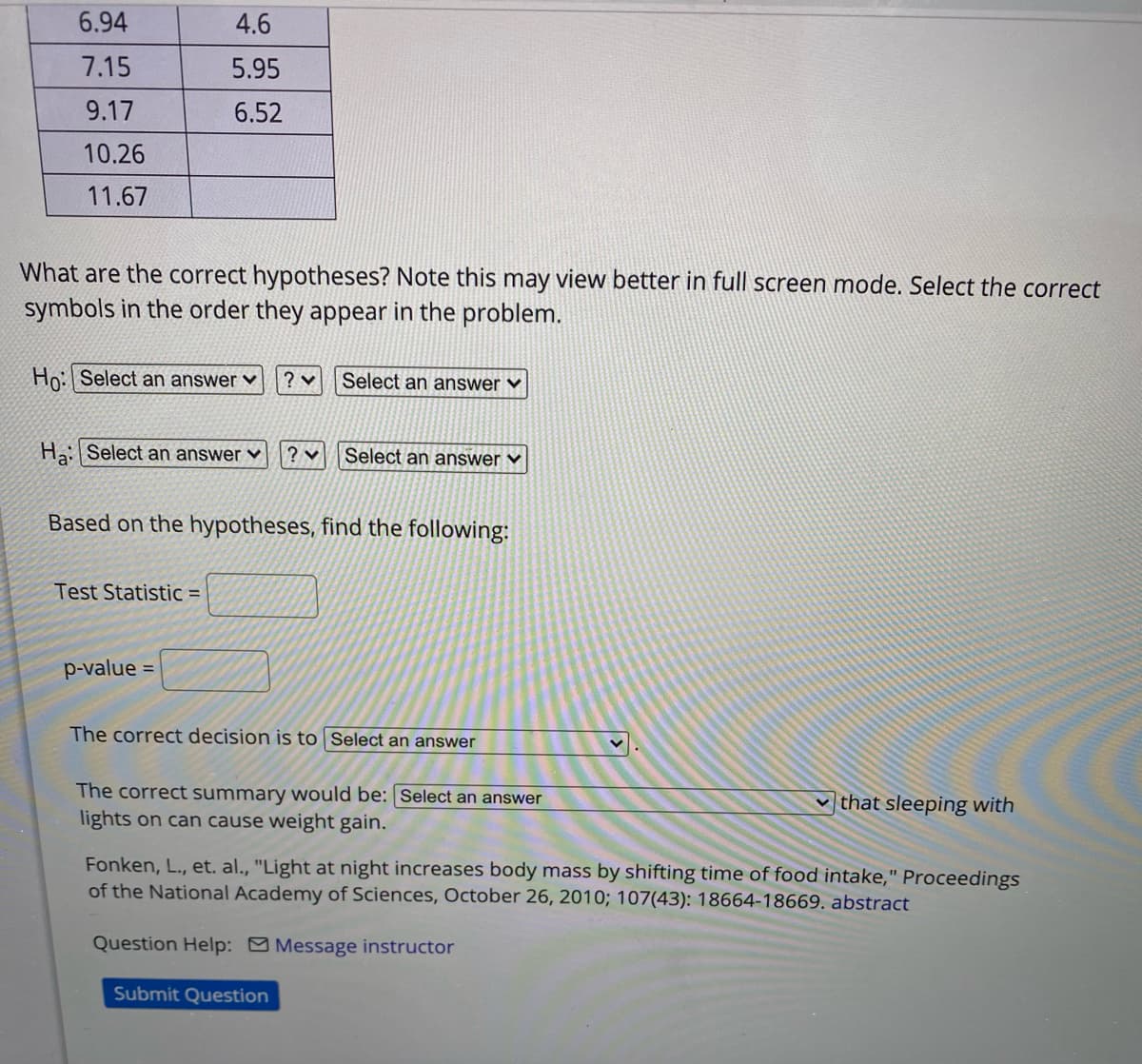You are testing the claim that having lights on at night increases weight gain (abstract). A sample 10 mice lived in an environment with bright light on all of the time and 8 mice who lived in an environment with a normal light/dark cycle is given below. Test the claim using a 10% level of significance. Assume the population variances are unequal and that the weight changes are normally distributed. Give answers to 3 decimal places.
You are testing the claim that having lights on at night increases weight gain (abstract). A sample 10 mice lived in an environment with bright light on all of the time and 8 mice who lived in an environment with a normal light/dark cycle is given below. Test the claim using a 10% level of significance. Assume the population variances are unequal and that the weight changes are normally distributed. Give answers to 3 decimal places.
MATLAB: An Introduction with Applications
6th Edition
ISBN:9781119256830
Author:Amos Gilat
Publisher:Amos Gilat
Chapter1: Starting With Matlab
Section: Chapter Questions
Problem 1P
Related questions
Topic Video
Question
NEED ANSWER FOR BOTH ASAP BOTH ARE FOR SAME QUESTION

Transcribed Image Text:You are testing the claim that having lights on at night increases weight gain (abstract). A sample of
10 mice lived in an environment with bright light on all of the time and 8 mice who lived in an
environment with a normal light/dark cycle is given below. Test the claim using a 10% level of
significance. Assume the population variances are unequal and that the weight changes are
normally distributed. Give answers to 3 decimal places.
Light (c1)
Dark (x2)
1.71
2.27
4.67
2.53
4.99
2.83
5.33
4
5.43
4.21
6.94
4.6
7.15
5.95
9.17
6.52
10.26
11.67
What are the correct hypotheses? Note this may view better in full screen mode. Select the correct
symbols in the order they appear in the problem.
Ho: Select an answer v ? vSelect an answer v
Ha: Select an answer v
Select an answer v
Based on the hypotheses, find the following:
Test Statistic =
p-value =
The correct decision is to Select an answer

Transcribed Image Text:6.94
4.6
7.15
5.95
9.17
6.52
10.26
11.67
What are the correct hypotheses? Note this may view better in full screen mode. Select the correct
symbols in the order they appear in the problem.
Ho: Select an answer ♥
Select an answer ♥
Ha: Select an answer ♥
? v
Select an answer ♥
Based on the hypotheses, find the following:
Test Statistic =
p-value
%3D
The correct decision is to Select an answer
The correct summary would be: Select an answer
lights on can cause weight gain.
that sleeping with
Fonken, L., et. al., "Light at night increases body mass by shifting time of food intake," Proceedings
of the National Academy of Sciences, October 26, 2010; 107(43): 18664-18669. abstract
Question Help: Message instructor
Submit Question
Expert Solution
This question has been solved!
Explore an expertly crafted, step-by-step solution for a thorough understanding of key concepts.
This is a popular solution!
Trending now
This is a popular solution!
Step by step
Solved in 2 steps with 1 images

Knowledge Booster
Learn more about
Need a deep-dive on the concept behind this application? Look no further. Learn more about this topic, statistics and related others by exploring similar questions and additional content below.Recommended textbooks for you

MATLAB: An Introduction with Applications
Statistics
ISBN:
9781119256830
Author:
Amos Gilat
Publisher:
John Wiley & Sons Inc

Probability and Statistics for Engineering and th…
Statistics
ISBN:
9781305251809
Author:
Jay L. Devore
Publisher:
Cengage Learning

Statistics for The Behavioral Sciences (MindTap C…
Statistics
ISBN:
9781305504912
Author:
Frederick J Gravetter, Larry B. Wallnau
Publisher:
Cengage Learning

MATLAB: An Introduction with Applications
Statistics
ISBN:
9781119256830
Author:
Amos Gilat
Publisher:
John Wiley & Sons Inc

Probability and Statistics for Engineering and th…
Statistics
ISBN:
9781305251809
Author:
Jay L. Devore
Publisher:
Cengage Learning

Statistics for The Behavioral Sciences (MindTap C…
Statistics
ISBN:
9781305504912
Author:
Frederick J Gravetter, Larry B. Wallnau
Publisher:
Cengage Learning

Elementary Statistics: Picturing the World (7th E…
Statistics
ISBN:
9780134683416
Author:
Ron Larson, Betsy Farber
Publisher:
PEARSON

The Basic Practice of Statistics
Statistics
ISBN:
9781319042578
Author:
David S. Moore, William I. Notz, Michael A. Fligner
Publisher:
W. H. Freeman

Introduction to the Practice of Statistics
Statistics
ISBN:
9781319013387
Author:
David S. Moore, George P. McCabe, Bruce A. Craig
Publisher:
W. H. Freeman